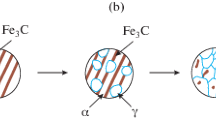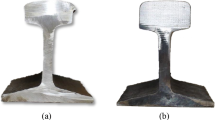Abstract
Oxide inclusions such as gray spots are the main defects caused by rail flash butt welding (FBW). An appropriate temperature field and upsetting process are essential for the extrusion of joint impurities. This study constructed a thermomechanical coupling model for the solid-state upsetting process of rail FBW through a combination of finite element simulation and experiment. Subsequently, the effects of different temperature fields and upsetting parameters on the extrusion behavior of impurities were studied. The results show that when the lateral deformation of the joint is not considered, selecting the appropriate upsetting length and increasing the width of the high-temperature plastic zone are beneficial for the extrusion of harmful impurities. Moreover, using variable speed upsetting or increasing the speed of the early upsetting facilitates the extrusion of impurities. However, the impurities in the deeper areas of the rail are difficult to move, and they easily form gray spot defects if the oxide inclusions remain.


















Similar content being viewed by others
References
L.B. Godefroid, G.L. Faria, L.C. Cândido, and T.G. Viana: Fatigue failure of a flash butt welded rail. Procedia Mater. Sci. 3, 1896–1901 (2014).
D.H. Stone, H.C. Iwand, J. Kristan, and G.R. Lehnhoff: Flash butt rail weld vertical fractures. J. Fail. Anal. Prev. 15, 33–38 (2015).
X. Zhao, Y. Fan, Y. Liu, H. Wang, and P. Dong: Evaluation of fatigue fracture mechanism in a flash butt welding joint of a U75V type steel for railroad applications. Eng. Failure Anal. 55, 26–38 (2015).
Q. Zhang, L. Li, W. Ding, H.T. Song, and Z.K. Gao: Investigation on process and welded joint mechanical properties of bainitic steel rail flash butt welding. Key Eng. Mater. 723, 406–411 (2016).
Y. Ichiyama, M. Ichikawa, and T. Saito: The effect of upsetting conditions on flash weld toughness. Study on toughness improvement of flash welded joints in high strength steel. Weld. Int. 18, 683–691 (2004).
A. Zhang, F. Gao, X. Niu, and H. Luo: Prediction of gray-spot area in rail flash butt welded joint based on BP neural network. Trans. China Weld. Inst. 37, 11–14 (2016).
J. Shen, Z. Wei, X. Zhu, Y. Liang, Y. Liang, F. Jiang, and Z. Xiao: Microstructure evolution and mechanical properties of flash butt-welded Inconel718 joints. Mater. Sci. Eng., A 718, 34–42 (2018).
K. Ozakgul, F. Piroglu, and O. Caglayan: An experimental investigation on flash butt welded rails. Eng. Failure Anal. 57, 21–30 (2015).
Z. Xu, P. Lu, and Y. Shu: Microstructure and fracture mechanism of a flash butt welded 380CL steel. Eng. Failure Anal. 62, 199–207 (2016).
E. Zheng, J. Tian, and Y. Wu: On the nature and origin of flat-spot in flash-welded joint. Acta Metall. Sin. 23, 126–152 (1987).
A-N. Räsänen and J. Martikainen: Experimental review of metallurgical flash weld defects in welded joints: Essence of flat spots, penetrators and oxide inclusions. Sci. Technol. Weld. Joining 16, 471–476 (2011).
Y. Ichiyama and T. Saito: Factors affecting flash weldability in high strength steel—A study on toughness improvement of flash welded joints in high strength steel. Weld. Int. 18, 436–443 (2004).
N. Shajan, K.S. Arora, V. Sharma, and M. Shome: Effect of upset pressure on texture evolution and its correlation to toughness in flash butt joints. Sci. Technol. Weld. Joining 23, 434–440 (2018).
P. Lu, Z. Xu, K. Jiang, F. Ma, and Y. Shu: Influence of flash butt welding parameters on microstructure and mechanical properties of HSLA 590CL welded joints in wheel rims. J. Mater. Res. 32, 831–842 (2017).
X. Yu, L. Feng, S. Qin, Y. Zhang, and Y. He: Fracture analysis of U71Mn rail flash-butt welding joint. Case Stud. Eng. Failure Anal. 4, 20–25 (2015).
C.W. Ziemian, M.M. Sharma, and D.E. Whaley: Effects of flashing and upset sequences on microstructure, hardness, and tensile properties of welded structural steel joints. Mater. Des. 33, 175–184 (2012).
Y.C. Zhang, W. Jiang, H. Zhao, Z. Wei, and S.T. Tu: Brazed residual stress in a hollow-tube stacking: Numerical simulation and experimental investigation. J. Manuf. Process. 31, 35–45 (2018).
N. Ma, Z. Cai, H. Huang, D. Deng, H. Murakawa, and J. Pan: Investigation of welding residual stress in flash-butt joint of U71Mn rail steel by numerical simulation and experiment. Mater. Des. 88, 1296–1309 (2015).
H.Y. Kim and H.G. Kim: Numerical and experimental analysis of residual stresses in an arc welded lap joint and mapping of the residual stress field to a simplified finite element model. J. Mech. Sci. Technol. 31, 4895–4902 (2017).
F. Lionetto, S. Pappadà, G. Buccoliero, and A. Maffezzoli: Finite element modeling of continuous induction welding of thermoplastic matrix composites. Mater. Des. 120, 212–221 (2017).
A. Ren, Y. Ji, G. Zhou, Z. Yuan, B. Han, and Y. Li: Hot deformation behavior of V-microalloyed steel. J. Iron Steel Res. Int. 17, 55–60 (2010).
H. Dai, Q. Lv, K. Tan, and J. Yan: Investigation in thermal and mechanical simulation of upset deformation on U71Mn rail butt welding. J. China Railw. Soc. 05, 45–48 (2005).
B. McClain, S.A. Batzer, and G.I. Maldonado: A numeric investigation of the rake face stress distribution in orthogonal machining. J. Mater. Process. Technol. 123, 114–119 (2002).
Acknowledgments
This work was financially supported by a project funded by the National Key R&D Program of China under Grant 2016YFB1102603.
Author information
Authors and Affiliations
Corresponding author
Rights and permissions
About this article
Cite this article
Zhang, J., Zhang, X., Li, D. et al. Extrusion behavior of impurities in upsetting process of rail flash butt welding based on finite element method. Journal of Materials Research 34, 3351–3360 (2019). https://doi.org/10.1557/jmr.2019.221
Received:
Accepted:
Published:
Issue Date:
DOI: https://doi.org/10.1557/jmr.2019.221




